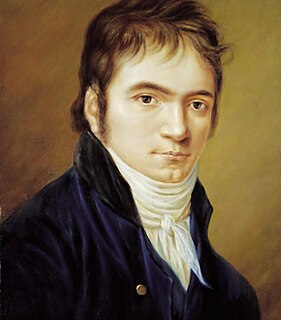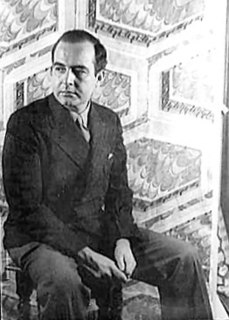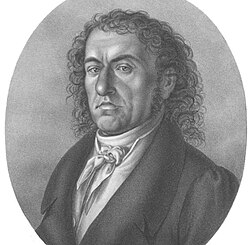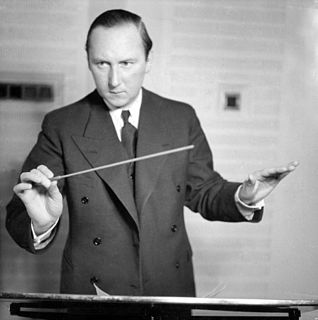Related Research Articles
Robert Wilfred Levick Simpson was an English composer, as well as a long-serving BBC producer and broadcaster.

Robert Eugene Ward was an American composer who is best remembered for his opera The Crucible (1961) after the 1953 play of the same name by Arthur Miller. He was awarded the Pulitzer Prize for Music for that opera in 1962.

The Symphony No. 94 in G major is the second of the twelve London symphonies written by Joseph Haydn. It is popularly known as the Surprise Symphony.

Ludwig van Beethoven's Symphony No. 1 in C major, Op. 21, was dedicated to Baron Gottfried van Swieten, an early patron of the composer. The piece was published in 1801 by Hoffmeister & Kühnel of Leipzig. It is not known exactly when Beethoven finished writing this work, but sketches of the finale were found to be from 1795.

The Symphony No. 2 in D major, Op. 36, is a symphony in four movements written by Ludwig van Beethoven between 1801 and 1802. The work is dedicated to Karl Alois, Prince Lichnowsky.

Adagio for Strings is a work by Samuel Barber, arguably his best known, arranged for string orchestra from the second movement of his String Quartet, Op. 11.

Ulvi Cemal Erkin was a member of the pioneer group of symphonic composers in Turkey, born in the period 1904–1910, who later came to be called The Turkish Five. These composers set out the direction of music in the newly established Turkish Republic. These composers distinguished themselves with their use of Turkish folk music and modal elements in an entirely Western symphonic style.

Sir George Dyson was an English musician and composer. After studying at the Royal College of Music (RCM) in London, and army service in the First World War, he was a schoolmaster and college lecturer. In 1938 he became director of the RCM, the first of its alumni to do so. As director he instituted financial and organisational reforms and steered the college through the difficult days of the Second World War.

Woldemar Bargiel was a German composer.
Samuel Barber's Symphony in One Movement, was completed 24 February 1936. It was premiered by Rome's Philharmonic Augusteo Orchestra under the baton of Bernardino Molinari on 13 December 1936. It lasts around 21 minutes. The title given in the printed score of the work is First Symphony , and the uniform title is Symphonies, no. 1, op. 9.

Franz Liszt composed his Prometheus in 1850, numbering it No. 5 in his cycle of symphonic poems when he revised it in 1855. The work is based on the Greek myth detailing the Titan Prometheus' theft of fire from the gods and is numbered S.99 in the Searle catalogue.
Finnish composer Einojuhani Rautavaara wrote his Symphony No. 7, subtitled Angel of Light, in 1994. It was originally known as The Bloomington Symphony, as it was commissioned to celebrate the 25th anniversary of the founding of the Bloomington Symphony Orchestra. Belonging to his Angel Series, inspired by childhood dreams and revelations, the symphony has won wide popularity for its deep spirituality. The premier performance was by the Bloomington Symphony Orchestra in 1994. In 1997 the premiere recording, by Segerstam, was nominated for the Grammy Award for "Best Classical Contemporary Composition".
Paul Spicer is an English composer, conductor, and organist. He taught choral conducting at the Royal College of Music and conducted the RCM Chamber Choir between 1995 and 2008. He currently teaches conducting at the Royal Birmingham Conservatoire and conducts their chamber choir which records for Somm Records. He also teaches at Oxford and Durham universities. Since 2004 he has been the conductor of the Petersfield Festival. He was Senior Producer for BBC Radio 3 for the Midlands Region based in Birmingham between 1984 and 1990 after which he moved to be artistic director of the Lichfield Festival. He also produced for various record companies over many years. He founded the Finzi Singers in 1984 making many recordings for Chandos Records. He conducts the Birmingham Bach Choir and the Whitehall Choir in London. His compositions include two oratorios for Easter and for Advent with libretti by the Dr Tom Wright and a choral symphony 'Unfinished Remembering' (2014) to a libretto by Euan Tait commemorating the outbreak of World War 1. He runs a series of choral courses under the banner of The English Choral Experience based mainly at Abbey Dore in Herefordshire.
A Cambridge Mass is a choral work in G major by Ralph Vaughan Williams written between 1898 and 1899 as part of his studies in Cambridge for his Doctorate of Music. It is one of two large scale choral works with orchestral accompaniment by Vaughan Williams surviving from this period, the other being a cantata setting of Swinburne's poem The Garden of Proserpine.

Josef Triebensee (Trübensee) was a Bohemian composer and oboist.
The Symphony No. 3 in B minor by the Ukrainian composer Borys Lyatoshynsky was completed in 1951, with the final movement themed "Peace will conquer war." The symphony was first performed in Kyiv on 23 October 1951, by the Kyiv Philharmonic, conducted by Natan Rakhlin. Criticised by the Soviet authorities on ideological grounds, the composer was forced to rework the symphony, and to remove the subtitle of the finale. The first performance of the revised version took place in Leningrad in 1955.

The Symphony No. 3 in C minor, Op. 34, is a four-movement orchestral composition written from 1944 to 1945 by the Swedish composer Lars-Erik Larsson. The piece premiered in Stockholm on 10 February 1946 with Tor Mann conducting the Concert Society Orchestra. In response to unfavorable critical reviews, Larsson immediately withdrew the symphony after its premiere—a fate that, too, had earlier befallen his First and Second symphonies.

The Symphony No. 2 in E minor, Op. 17, is a three-movement orchestral composition written from 1936 to 1937 by the Swedish composer Lars-Erik Larsson. The piece premiered in Stockholm on 24 November 1937 with Larsson conducting the Concert Society Orchestra. In response to unfavorable critical reviews, Larsson immediately withdrew the symphony after its premiere—a fate that, too, had earlier befallen his First and would later befall his Third symphonies.
References
- Notes
- ↑ Spicer 2014 , p. 69
- ↑ Spicer 2014 , pp. 70–71
- ↑ Spicer 2014 , pp. 71
- 1 2 Clinch 2017
- ↑ Matthew-Walker 2014
- Sources
- Clinch, Johnathan (15 February 2017). "Trust sponsors Choral Symphony recording". Sir George Dyson Trust. Retrieved 4 October 2017.
- Spicer, Paul (2014). Sir George Dyson: His Life and Music. Boydell & Brewer Ltd. ISBN 978-1-84383-903-3.
- Matthew-Walker, Robert (13 March 2014). "Review: New London Orchestra/Ronald Corp – Music by Stanford and Vaughan Williams – with Thomas Allen – and the world premiere of George Dyson's Choral Symphony" . Retrieved 4 October 2017.